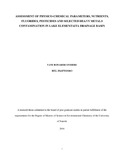| dc.description.abstract | This study aimed at assessing physio-chemical parameters, nutrients, fluoride, pesticides and selected heavy metals contamination in Lake Elementaita drainage basin. Water pollution has been identified globally as one of the most serious problems in environmental conservation. Pesticides, heavy metals and nutrients are of concern in the world waters and have been considered as long-term worldwide water pollutants since they cause deterioration of water quality and cause adverse effects on the lake ecosystem.
Water, sediments and soil were collected from seven sites within Lake Elementaita drainage basin and analysed for physico-chemical parameters, nutrients, fluoride, heavy metals and organochlorine pesticides (OCP) residues. The sampling strategy covered dry (October 2014) and wet (April 2015) season. Analysis of the 17 OCPs was done using gas chromatograph equipped with electron capture detector (GC-ECD), whereas for heavy metals analysis atomic absorption spectrometer was used. Physico-chemical parameters analysed included electrical conductivity, pH, TDS, TSS and temperature.
Nitrate and phosphate concentrations were below WHO maximum limits with dry season recording higher values. Phosphates concentrations ranged from 0.02±0.00 to 0.38±0.07 mg/L, 0.45±0.02 to 10.04±0.10 mg/kg and 0.78±0.00 to 4.47±0.03 mg/Kg in water, sediment and soil, respectively. Nitrates ranged from 0.43±0.04 to 3.00±0.36 mg/L, 0.36±0.06 to 2.21.02±0.18 mg/kg and 0.65±0.05 to 4.90±0.29 mg/kg in water, sediment and soil, respectively.
All the 17 OCPs were detected with concentrations below WHO maximum limits. The OCPS residues ranged from BDL to 0.49±0.09 μg/L, BDL to 762.27±91.70 μg/kg and BDL to 615.93±119.21 μg/kg in water, sediment and soil samples, respectively in dry season and BDL to
vi
0.16±0.00 μg/l, BDL to 42.97±1.00 μg/kg and BDL to 13.92±0.21 μg/kg in water, sediment and soil samples, respectively in wet season. Endosulphan sulphate recorded high concentration in soil and sediment samples in both seasons.
Concentrations of cadmium, copper, zinc and lead were above WHO maximum limits for water in some samples analysed with the wet season recording high values. Cadmium values ranged between 0.04±0.00 and 0.35±0.02 mg/L, 2.06±0.42 and 16.07±0.02 mg/kg, 2.78±0.08 and 29.75±0.14 mg/kg in water, sediment and soil, respectively. Copper concentrations ranged between 0.07±0.04 and 8.49±0.40 mg/L, 2.93±0.66 and 861.76±80.58 mg/kg, 2.96±0.39 and 865.83±5.76 mg/kg in water, sediment and soil, respectively. Lead concentrations ranged between BDL to 9.28±0.9 mg/L, BDL to 475.75±16.61mg/kg, 10.38±0.99 and 502.18±20.76 mg/kg in water, sediment and soil, respectively. Zinc concentration ranged between 0.14±0.00 and 0.41±0.02 mg/L, 45.73±9.44 and 106.28±2.89 mg/kg, 57.95±6.68 and 86.95±5.55 mg/kg in water, sediment and soil, respectively. Fluoride concentration in water ranged between 1.70±0.28 to 977.80±0.01 mg/L in Mbaruk River and Lake Elementaita North, respectively.
The results revealed high levels of heavy metals in water, soil and sediments which exceeded WHO maximum limits, whereas the concentrations of pesticides were below the maximum limits. Therefore heavy metal contamination was of concern for sustainable management of the lake water quality and biodiversity. Pesticide levels measured could also cause longer-term concern due to potential bioaccumulation and biomagnifications in the food chain. Further studies are recommended to establish the effect of measured contaminants on the lake ecosystems and flamingoes. | en_US |
| dc.description.department | a
Department of Psychiatry, University of Nairobi, ; bDepartment of Mental Health, School of Medicine,
Moi University, Eldoret, Kenya | |



